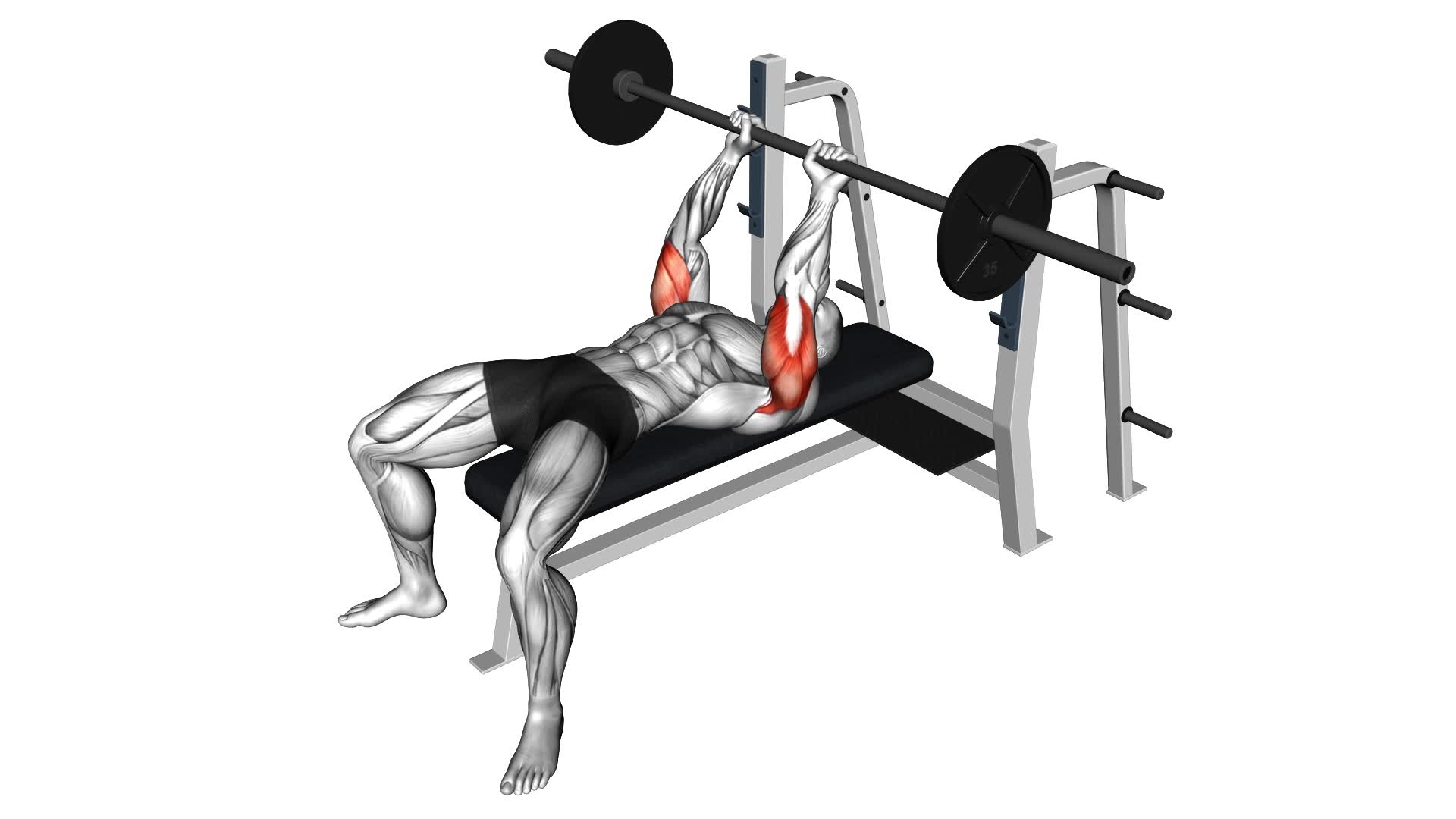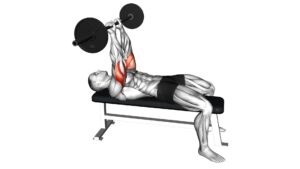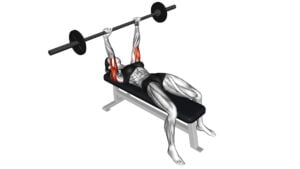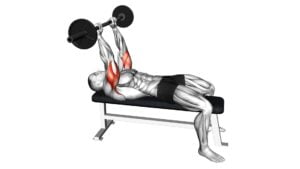Barbell Lying Extension – Video Exercise Guide & Tips

Looking to target your triceps and build upper body strength? Check out the Barbell Lying Extension!
Watch This Exercise Video
In this exercise, you'll lie on a bench and extend the barbell overhead, engaging those triceps. This guide provides step-by-step instructions and tips to ensure proper form and technique.
Plus, there's a helpful video to guide you through the exercise. Get ready to sculpt those arms and take your workout to the next level!
Key Takeaways
- Barbell lying extension targets and strengthens the triceps.
- Engaging stabilizer muscles in the shoulders and chest enhances upper body stability and control.
- Proper form and technique are crucial for preventing injury and maximizing muscle activation during the exercise.
- Variations and progressions, such as incline or close-grip variations, can be used to challenge the triceps and improve overall strength.
Benefits of Barbell Lying Extension
Experience the numerous benefits of the Barbell Lying Extension for a stronger and more defined upper body. This exercise primarily targets the triceps, the muscles located at the back of your upper arm. By performing this exercise regularly, you can enjoy several advantages.
One of the key advantages of the Barbell Lying Extension is its ability to effectively isolate and target the triceps. This exercise allows you to specifically focus on strengthening and toning these muscles, leading to increased arm strength and definition. Additionally, the Barbell Lying Extension engages the stabilizer muscles in your shoulders and chest, further enhancing upper body stability and control.
Another advantage of this exercise is its versatility. By adjusting the weight and repetitions, you can tailor the Barbell Lying Extension to suit your fitness goals. Whether you aim to build muscle mass or improve muscular endurance, this exercise can be modified accordingly.
However, it's important to note that like any exercise, the Barbell Lying Extension also has its disadvantages. The main drawback is the potential strain it can put on your elbows and wrists if performed with improper form or excessive weight. It's crucial to maintain proper technique and gradually increase the weight to minimize the risk of injury.
Equipment and Set-Up
To maximize the effectiveness of the barbell lying extension exercise, it's crucial to select the proper equipment and set up your position correctly. Choose a barbell that's appropriate for your strength and fitness level.
Additionally, ensure that you have a stable and secure bench or mat to lie on during the exercise. By paying attention to these details, you can optimize your performance and minimize the risk of injury.
Proper Equipment Selection
Choose the appropriate barbell and set up your equipment correctly for the barbell lying extension. When selecting a barbell, ensure that it's the appropriate weight for your fitness level and goals. The barbell should be in good condition, with no signs of wear or damage. Regular equipment maintenance is important to prevent accidents and ensure safe workouts.
Next, set up your equipment by lying flat on a bench with your feet planted firmly on the ground. Your head should be positioned at the edge of the bench, allowing for a full range of motion. Keep your back straight and grip the barbell with an overhand grip, slightly wider than shoulder-width apart.
Now you're ready to perform the barbell lying extension exercise effectively and safely. Remember, if the barbell lying extension is too challenging, there are alternative exercises that can target the same muscle groups.
Optimal Set-Up Technique
To optimize your equipment and set-up for the barbell lying extension, there are a few key techniques you can employ.
First, ensure that you have a stable and supportive bench. The bench should be positioned so that your head and shoulders are comfortably supported, and your feet are planted firmly on the ground.
Next, grip the barbell with a shoulder-width grip, allowing for proper alignment and control. This grip will help you maintain stability as you perform the exercise.
As you lower the barbell towards your forehead, focus on maintaining a neutral spine and engaging your core muscles. This will help you improve flexibility and prevent any strain on your lower back.
Finally, when extending the barbell back up, exhale and contract your triceps to fully activate the muscles. This will ensure that you are getting the most out of the exercise and targeting the intended muscle group.
Proper Form and Technique
Begin by positioning your body on a flat bench with a barbell in your hands, ensuring proper form and technique for the barbell lying extension exercise. To prevent injuries, it's important to maintain a strong and stable core throughout the movement. Keep your feet flat on the ground and firmly planted for stability.
Grip the barbell with an overhand grip, slightly wider than shoulder-width apart. Lower the barbell slowly towards your forehead, keeping your elbows tight and close to your head. Avoid forcefully bending your wrists or allowing them to bend back.
Engage your triceps to extend your arms and lift the barbell back to the starting position. Common mistakes to avoid include arching your back excessively, using momentum to lift the weight, or bending your elbows too much. Remember to maintain control throughout the exercise and focus on using your triceps to perform the movement.
Now that you understand the proper form and technique for the barbell lying extension, let's move on to variations and progressions to continue challenging your triceps and improving your strength.
Variations and Progressions
To challenge your triceps and continue improving your strength, you can explore different variations and progressions of the barbell lying extension exercise. By incorporating advanced modifications and muscle targeting techniques, you can take your workout to the next level.
One variation you can try is the incline barbell lying extension. Instead of lying flat on a bench, adjust the bench to a slight incline. This variation targets the upper portion of your triceps and adds an extra challenge to your workout.
Another modification is the close-grip barbell lying extension. By bringing your hands closer together on the barbell, you place more emphasis on the inner head of your triceps. This variation helps to develop the horseshoe shape of your triceps.
To increase the difficulty of the exercise, you can progress to using heavier weights or performing more repetitions. Remember to maintain proper form and control throughout the movement.
Now that you have explored different variations and progressions of the barbell lying extension exercise, it's important to be aware of common mistakes to avoid.
Common Mistakes to Avoid
To ensure you perform the barbell lying extension correctly and avoid common mistakes, it's important to pay attention to proper form.
Watch the demonstration video to understand the correct technique and position your body accordingly.
Additionally, prioritize injury prevention by using appropriate weights, engaging your core, and maintaining a controlled movement throughout the exercise.
Lastly, if you notice any common errors in your form, take the time to correct them to maximize the effectiveness of the exercise and minimize the risk of injury.
Proper Form Demonstration
Ensure proper form during the barbell lying extension exercise by avoiding common mistakes. Proper alignment is crucial to prevent injury and maximize muscle activation.
Start by lying flat on your back with your knees bent and feet planted firmly on the ground. Place your hands shoulder-width apart on the barbell, palms facing down. Keep your elbows tucked in and close to your body throughout the exercise.
As you extend your arms, make sure to maintain a straight line from your shoulders to your fingertips. Avoid arching your back or allowing your shoulders to shrug. Focus on engaging your triceps and keeping your core muscles tight.
Injury Prevention Techniques
Avoiding common mistakes is crucial for preventing injuries during the barbell lying extension exercise. To ensure your safety, here are some injury prevention tips.
First, make sure to warm up properly before starting the exercise. This helps to increase blood flow to your muscles and decrease the risk of injury.
Additionally, maintain proper form throughout the exercise. Keep your back flat on the bench, your core engaged, and your elbows close to your body.
Avoid using excessive weight that you can't handle, as this can strain your muscles and joints.
Finally, listen to your body and take breaks when needed. Pushing through pain can lead to injuries.
By following these injury prevention techniques, you can minimize the risk of harm during the barbell lying extension exercise.
Now, let's move on to correcting common errors.
Correcting Common Errors
To prevent injuries during the barbell lying extension exercise, it's important to correct common errors that may occur.
One common mistake to avoid is using too much weight. It's crucial to start with a weight that you can handle and gradually increase it as you become stronger.
Another mistake is arching your back excessively. This puts unnecessary strain on your spine and can lead to injury. Make sure to maintain a neutral spine throughout the exercise.
Additionally, avoid locking your elbows at the top of the movement. This can cause joint strain and increase the risk of injury.
Lastly, rushing through the exercise and sacrificing form is another common mistake. Take your time and perform the movement with control to maximize effectiveness and minimize the risk of injury.
Tips for a More Effective Workout
Use proper form to maximize the effectiveness of your barbell lying extension workout. By following these tips, you can improve muscle activation and maximize your results:
- Maintain a flat back: Keep your spine neutral throughout the exercise. Avoid arching or rounding your back, as this can lead to strain and ineffective muscle activation. Engage your core to stabilize your spine.
- Focus on the triceps: To target the triceps effectively, keep your upper arms perpendicular to the ground throughout the movement. Avoid letting your elbows flare out to the sides, as this can shift the emphasis away from the triceps.
- Control the movement: Slow and controlled repetitions are key to an effective workout. Avoid using momentum or swinging the weight. Lower the barbell with control and extend your arms fully at the top of the movement.
- Adjust the weight: Start with a weight that challenges you but allows you to maintain proper form. Gradually increase the weight as you get stronger. Using too heavy of a weight can compromise your form and hinder the effectiveness of the exercise.
By implementing these tips, you can ensure that your barbell lying extension workout is effective and helps you achieve your fitness goals.
Remember to listen to your body and adjust as needed to maintain proper form and maximize your results.
Frequently Asked Questions
How Many Sets and Reps Should I Do for the Barbell Lying Extension Exercise?
For the barbell lying extension exercise, it's important to find the optimal weight and progression that works for you. This will vary depending on your fitness level and goals. Start with a weight that challenges you but still allows for proper form.
Aim for 3-4 sets of 8-12 reps, gradually increasing the weight as you get stronger.
Common mistakes to avoid include using too much weight, lifting your hips off the bench, and not fully extending your arms.
Can I Use Dumbbells Instead of a Barbell for This Exercise?
Yes, you can use dumbbells instead of a barbell for the barbell lying extension exercise.
Dumbbells are a great alternative equipment for this exercise as they provide a different grip and allow for greater range of motion.
Just make sure to choose dumbbells that are appropriate for your strength level and always maintain proper form throughout the exercise.
Is It Necessary to Have a Spotter While Performing the Barbell Lying Extension?
When performing the barbell lying extension, it isn't necessary to have a spotter. However, having a spotter can provide some benefits.
Pros of having a spotter include added safety and assistance in completing the exercise properly.
Cons include relying on someone else and potential interruptions in your workout flow.
Variations and modifications can be done with this exercise to target different muscles and accommodate different fitness levels.
How Often Should I Incorporate the Barbell Lying Extension Into My Workout Routine?
To determine the optimal frequency of incorporating the barbell lying extension into your workout routine, consider your goals and overall fitness level. It's important to allow your muscles enough time to recover between sessions, so two to three times a week is a good starting point.
As for the weight, choose a challenging yet manageable load that allows you to complete the exercise with proper form. Remember to gradually increase the weight as you become stronger and more comfortable with the movement.
Are There Any Specific Muscles Targeted by the Barbell Lying Extension Exercise That Are Not Mentioned in the Article?
When performing the barbell lying extension exercise, it primarily targets your triceps, but there are other muscles involved as well. Although the article doesn't mention them specifically, the exercise also engages your shoulders and chest to a lesser extent.
If you're looking to target these muscles more directly, you may want to consider alternative exercises such as tricep dips or close grip bench press.
The barbell lying extension offers benefits like strengthening your triceps and improving upper body pushing movements.
Conclusion
In conclusion, the barbell lying extension is a highly effective exercise for targeting the triceps muscles. It offers numerous benefits such as improved arm strength and muscle definition.
By following proper form and technique, variations and progressions can be incorporated to challenge and further enhance the workout. Avoiding common mistakes and implementing tips for a more effective workout will ensure optimal results.
Incorporating the barbell lying extension into your fitness routine can greatly contribute to your overall arm strength and muscle development.

Author
Years ago, the spark of my life’s passion ignited in my mind the moment I stepped into the local gym for the first time. The inaugural bead of perspiration, the initial endeavor, the very first surge of endorphins, and a sense of pride that washed over me post-workout marked the beginning of my deep-seated interest in strength sports, fitness, and sports nutrition. This very curiosity blossomed rapidly into a profound fascination, propelling me to earn a Master’s degree in Physical Education from the Academy of Physical Education in Krakow, followed by a Sports Manager diploma from the Jagiellonian University. My journey of growth led me to gain more specialized qualifications, such as being a certified personal trainer with a focus on sports dietetics, a lifeguard, and an instructor for wellness and corrective gymnastics. Theoretical knowledge paired seamlessly with practical experience, reinforcing my belief that the transformation of individuals under my guidance was also a reflection of my personal growth. This belief holds true even today. Each day, I strive to push the boundaries and explore new realms. These realms gently elevate me to greater heights. The unique combination of passion for my field and the continuous quest for growth fuels my drive to break new ground.







